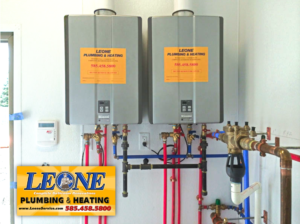
Rinnai tankless water heater installed by Leone Plumbing and Heating.
Tankless water heaters are growing popular with homeowners. Many homes are enjoying the advantage of going tankless. With the growing demand for tankless water heaters, we are picky in choosing the right unit for our installation service. One of the products that we highly recommend is the Rinnai tankless water heater.
Why Choose Rinnai Tankless Water Heater?
In your everyday domestic activities, there will be many instances in which you need hot water to get something done. You may need hot water every time you wash clothes, shower, bathing, doing dishes, and many others. Hot water can be highly on-demand in your home, and you need a heavy-duty water heater. Rinnai tankless water heater has all the elements that a heavy-duty unit must have – available hot water on demand, durable, and energy-efficient.
The Pros and Cons of Rinnai Tankless Water Heater
While we highly recommend Rinnai tankless water heater, there is no perfect product. Though we receive generally good points from this product, there are
pros and cons too.
Pros:
Energy Saving
Rinnai tankless water heater only operates during the time you need it. That means less energy consumption. The traditional water heater, however, heats the water to a certain degree and stores the water in there (whether you need it or not). It will consume more energy to maintain the temperature throughout the day – which will translate to high energy bills. With a tankless water heater, you will save up to 50% of energy consumption.
Hot Water On Demand
It will take you several minutes to get hot water from a regular tank heater. But with a Rinnai tankless unit, hot water is available in seconds. The perk of having a tankless system is it provides a constant flow of hot water for as long as your household needs it.
Space-Saving
A tankless water heater is ideal for a home that wants enough space for other things. Rinnai tankless units don’t have large holding tanks so they can fit in any small spaces.
It Can Last Longer
Compared to a regular tank heater that can last for 10 years, Rinnai tankless units have a longer lifespan of about 20 years! That is how durable it is.
Cons:
Higher Purchase Cost
Rinnai tankless water heaters are costly to purchase and install compared to conventional heaters. Though the upfront cost is larger, it will save you money on energy bills throughout the year.
Large Units For Big Families
A small unit may not be able to keep up the demand of a household all at once. If you have a big family which uses the unit at the same time, you will need a large Rinnai tankless unit which costs more.
Go Tankless!
It is a wise investment to have a Rinnai tankless unit at home. If you want to go tankless or
get your current unit serviced, we are always available for you!
Talk to us today to find out more.
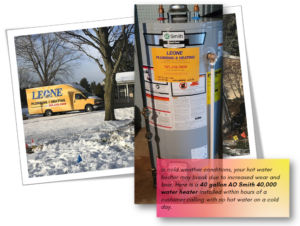 It’s the most wonderful time of the year! Can you feel it? Having a steamy shower over a cold icy day beats the chill that the winter season brings. Your best friend is a hot water heater providing the exact warmth that you need. But like any appliance during the winter, it can be vulnerable to issues brought about by the cold weather. In this article, we will talk about the steps to prevent water heater issues from occurring this winter.
It’s the most wonderful time of the year! Can you feel it? Having a steamy shower over a cold icy day beats the chill that the winter season brings. Your best friend is a hot water heater providing the exact warmth that you need. But like any appliance during the winter, it can be vulnerable to issues brought about by the cold weather. In this article, we will talk about the steps to prevent water heater issues from occurring this winter.
 It’s the most wonderful time of the year! Can you feel it? Having a steamy shower over a cold icy day beats the chill that the winter season brings. Your best friend is a hot water heater providing the exact warmth that you need. But like any appliance during the winter, it can be vulnerable to issues brought about by the cold weather. In this article, we will talk about the steps to prevent water heater issues from occurring this winter.
It’s the most wonderful time of the year! Can you feel it? Having a steamy shower over a cold icy day beats the chill that the winter season brings. Your best friend is a hot water heater providing the exact warmth that you need. But like any appliance during the winter, it can be vulnerable to issues brought about by the cold weather. In this article, we will talk about the steps to prevent water heater issues from occurring this winter.
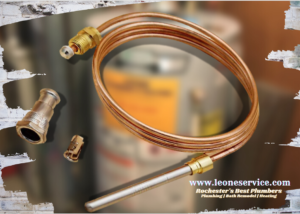 Your water heater is one of your house appliances that serve a lot of benefits for your home. It gives hot water needed for your hot drinks, showers, baths, laundry, and dishes. Every part of it is important especially the water heater thermocouple. But what if it suddenly dysfunctions and needs replacement? Can you replace it by yourself? If you can’t, let us tell you how.
Your water heater is one of your house appliances that serve a lot of benefits for your home. It gives hot water needed for your hot drinks, showers, baths, laundry, and dishes. Every part of it is important especially the water heater thermocouple. But what if it suddenly dysfunctions and needs replacement? Can you replace it by yourself? If you can’t, let us tell you how.

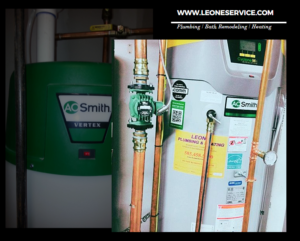 Water heaters are one of the important appliances in your home that you need to maintain. As a certified AO Smith Hot Water Heater technician, we know very well how to maintain the unit. If you own an AO Smith Hot Water Heater or planning to have one, this article will help you how to maintain the unit safely on your own.
Water heaters are one of the important appliances in your home that you need to maintain. As a certified AO Smith Hot Water Heater technician, we know very well how to maintain the unit. If you own an AO Smith Hot Water Heater or planning to have one, this article will help you how to maintain the unit safely on your own.

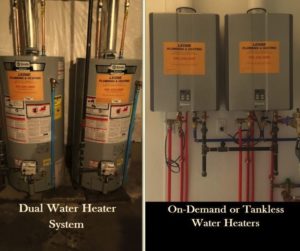 Why would someone install a dual water heater system in their home? A couple of reasons! A common one is that it’s a large family household and multiple people are using hot water for various reasons and in large amounts, such as multiple showers and bathrooms. Another is that they have a whirlpool bathtub that requires many gallons of water. Most whirlpools start at 65-gallons while most houses only have a standard 40-gallon tank installed. One solution is to have a 2nd 40 or 50-gallon tank installed alongside the first.
Leone Plumbing has installed these for their customers using a custom built manifold system to link the two together. This has a few benefits.
Why would someone install a dual water heater system in their home? A couple of reasons! A common one is that it’s a large family household and multiple people are using hot water for various reasons and in large amounts, such as multiple showers and bathrooms. Another is that they have a whirlpool bathtub that requires many gallons of water. Most whirlpools start at 65-gallons while most houses only have a standard 40-gallon tank installed. One solution is to have a 2nd 40 or 50-gallon tank installed alongside the first.
Leone Plumbing has installed these for their customers using a custom built manifold system to link the two together. This has a few benefits.